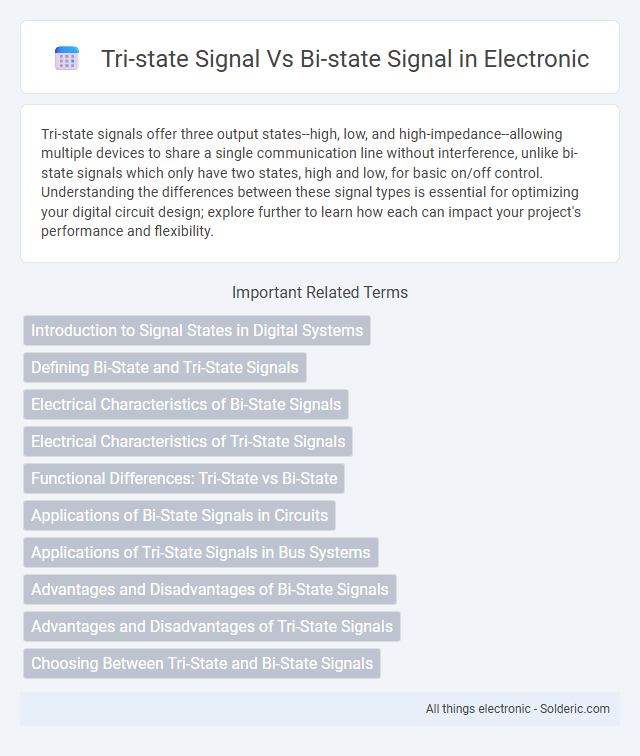Tri-state signals offer three output states--high, low, and high-impedance--allowing multiple devices to share a single communication line without interference, unlike bi-state signals which only have two states, high and low, for basic on/off control. Understanding the differences between these signal types is essential for optimizing your digital circuit design; explore further to learn how each can impact your project's performance and flexibility.
Comparison Table
| Feature | Tri-State Signal | Bi-State Signal |
|---|---|---|
| Number of States | Three (High, Low, High Impedance) | Two (High, Low) |
| High Impedance State | Yes, effectively disconnects output | No, always drives High or Low |
| Usage | Bus sharing and multiple device control | Simple ON/OFF signaling |
| Complexity | Higher due to additional state management | Simpler design and control |
| Power Consumption | Lower in High Impedance state | Consistent power usage when driven |
| Applications | Memory buses, multiplexers, bidirectional data lines | LED indicators, switches, basic digital signals |
Introduction to Signal States in Digital Systems
Digital systems utilize signal states to represent information, with bi-state signals offering two distinct levels, typically high (1) and low (0), corresponding to binary logic. Tri-state signals extend this concept by adding a third state, known as high impedance (Z), enabling multiple outputs to share a single communication line without interference. The high impedance state effectively disconnects the signal from the line, allowing for more complex bus architectures and efficient resource sharing in digital circuits.
Defining Bi-State and Tri-State Signals
Bi-state signals operate with two voltage levels representing binary states, typically 0 and 1, ensuring clear on/off logic for digital circuits. Tri-state signals add a third state, high impedance (Z), allowing the output to effectively disconnect from the circuit, enabling multiple devices to share a common communication line without interference. Your designs benefit from tri-state signals by improving bus management and minimizing data conflicts in complex digital systems.
Electrical Characteristics of Bi-State Signals
Bi-state signals operate with two defined voltage levels representing binary states, typically 0 volts (low) and a specified positive voltage (high), ensuring clear digital logic interpretation. These signals exhibit fast switching times and low noise margins, optimized for simple on-off control in digital circuits. Your design benefits from bi-state signals' straightforward electrical characteristics, making them ideal for applications requiring reliable binary data transmission without intermediate states.
Electrical Characteristics of Tri-State Signals
Tri-state signals differ from bi-state signals by offering a third high-impedance (Hi-Z) state, which effectively disconnects the output from the circuit, allowing multiple devices to share the same bus without interference. This electrical characteristic reduces power consumption and prevents signal contention, enhancing system reliability in digital communication. Your design benefits from tri-state signals when managing shared data lines in complex integrated circuits.
Functional Differences: Tri-State vs Bi-State
Tri-state signals feature three distinct output states: high, low, and high-impedance, enabling multiple devices to share a common data bus without interference. Bi-state signals only toggle between two states, high and low, limiting their use in bus systems where data from multiple sources must be isolated. The high-impedance state in tri-state circuits effectively disconnects the device from the bus, preventing data conflicts in complex digital systems.
Applications of Bi-State Signals in Circuits
Bi-state signals, representing two distinct voltage levels commonly used as logic high and logic low, are fundamental in digital circuits such as microprocessors, memory devices, and simple on/off switches. Their straightforward binary nature makes them ideal for applications requiring definitive state control without intermediate states, ensuring signal clarity and reliable data processing. Understanding how your circuit leverages bi-state signals can enhance performance in logic gates, flip-flops, and communication interfaces requiring clear, unambiguous signaling.
Applications of Tri-State Signals in Bus Systems
Tri-state signals enable multiple devices to share a common data bus by allowing each device to drive the bus line, output a logical high, low, or enter a high-impedance state that effectively disconnects it from the bus. This high-impedance state prevents signal contention and ensures data integrity in bus systems such as memory modules, microprocessors, and peripheral interfaces. Your digital circuit design benefits from tri-state buffers by enhancing bus efficiency and enabling easier expansion of connected devices without interference.
Advantages and Disadvantages of Bi-State Signals
Bi-state signals represent binary states, typically high (1) and low (0), simplifying circuit design and reducing complexity in digital systems. Your circuits benefit from easier implementation and lower cost, but these signals lack the high-impedance state found in tri-state signals, which limits their ability to allow multiple devices to share a single communication line. The absence of a third state can cause bus contention and increased power consumption, making bi-state signals less flexible for complex bus architectures.
Advantages and Disadvantages of Tri-State Signals
Tri-state signals offer the advantage of enabling multiple devices to share a single communication line by adding a high-impedance state, which effectively disconnects the device from the bus and prevents signal interference. This capability reduces wiring complexity and allows more efficient use of I/O pins on microcontrollers or FPGA devices. However, tri-state signals can introduce challenges such as increased design complexity, potential signal contention if multiple devices drive the bus simultaneously, and slower signal transition times compared to bi-state signals.
Choosing Between Tri-State and Bi-State Signals
Choosing between tri-state and bi-state signals depends on your application's need for channel sharing and bus complexity. Tri-state signals offer a high-impedance state that allows multiple devices to share a single communication line without interference, ideal for complex bus architectures. Bi-state signals provide only two levels, making them simpler and faster for point-to-point connections where bus sharing is unnecessary.
tri-state signal vs bi-state signal Infographic

 solderic.com
solderic.com